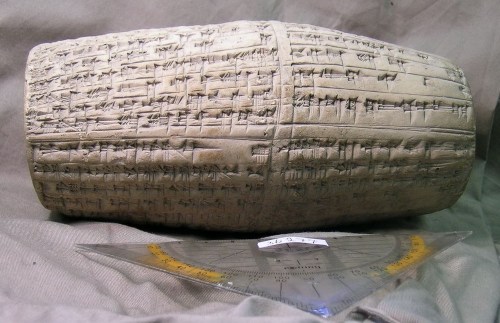Kvanvig: Introducing the Apkallu Odakon
“In the first survey of the Sumerian tablets found in Tell Haddad, ancient Meturan, from 1993, A. Cavigneaux and F. Al-Rawi call attention to two pieces containing the Adapa Myth in Sumerian. They are dated to the Old Babylonian period.
Since the manuscripts are not yet published, we have to rely on the description of content given in this survey. The Sumerian version is close to to the Akkadian Amarna tablet and the Nineveh tablets already known (we return to this issue below).
What is of interest in our context here is that in the Sumerian version of the Adapa Myth proper is preceded by an introduction of about 100 lines. In this fragmentary introduction there is a reference to the flood, and the central concern is the feeding of the gods and the organization of humankind from the end of Atrahasis; the Royal Chronicle of Lagash describes the reorganization of humankind after the flood.
Since the fragmentary beginning of the manuscript is not published, we can, however, not be certain at what stage the feeding of the gods and the organization of humankind took place.
We have seen in the Eridu Genesis that there seems to be a pairing of the situation of humankind at the very beginning when they lived without proper culture with their situation after the flood when they had to start from the beginning again.
Anyway, the Sumerian version of the Adapa Myth demonstrates that Berossos was not the first to include the myth about the great primeval apkallu, Adapa, in the primeval history. This was already done in the Old Babylonian period.

The god Ea at far left, wearing the horned headdress indicative of divinity, with water coursing from his shoulders. A fish-apkallū is in the iconic posture with right hand raised in blessing or exorcism, with the banduddu bucket in his left hand. The next apkallū wields an indistinct and as yet undefined angular object in his right hand, with the typical banduddu bucket in his left. The entity at far right, which appears to be wearing a horned tiara indicative of divinty, remains unidentified and undefined.
Berossos had nothing specific to say about the other five monsters / sages, except that their appearances were like Oannes. About the seventh sage, he has a special report:
“During his reign (Enmeduranki’s) there also appeared from the Red Sea (Persian Gulf) another man-fish being whose name was Odakon. Berossos says that this monster explained in detail what Oannes originally had said in summary fashion.”
(Eusebius, (Arm.) Chronicles p. 4, 8-6, 8 and Syncellus 71, 3).
This information is a bit confusing, because Oannes had already taught everything necessary to know. In some strange way, Odakon seems to be a double twin of Oannes.

Antediluvian apkallū portrayed as fish-men, such mixed-species creatures were the teachers of men, with Oannes and Odakon from Berossos the exemplars.
These specific statuettes were buried in the foundations of the home of an exorcist, where they were positioned beneath doorways and against particular walls to exert a prophylactic effect, warding off evil.
The antediluvian type of apkallū, the so-called paradu fish, are often grouped in sevens.
Berossos does not record sages or scholars after the flood, but there is one exception that is attested both by Josephus in Jewish Antiquities I, 158 and Eusebius in Praeperatio Evangelica 9.16.2. We quote from Josephus:
“Berossos records our father Abraham. He does not mention him by name but reports the following. After the flood, in the tenth generation, among the Chaldeans there was a man, great, just, and all-knowing about the heavens.”
Now, if we had not known the Uruk tablet, we would have deemed Josephus’ information as an unhistorical theological speculation. Of course, it would have been nice to find the father of Israel whose origin according to Genesis 11-12 is Chaldean, listed among the great sages of the past in a Babylonian document.
The Uruk tablet draws, however, on a tradition very similar to the one we can recognize in Berossos: listing kings and sages together, the sages in the same order, and seven before the flood.
Then the Uruk tablet lists ten new sages / scholars after the flood and makes the surprising remark that the tenth of these was known by the Arameans, in Aramaic language, in the West, as Ahiqar.
We are in the fortunate position to verify this; both a novel about and proverbs by Ahiqar were circulating in the West both prior to the Uruk tablet and prior to Berossos. We must assume that Berossos knew what the author of the Uruk tablet knew: there existed in the West traditions about this great, righteous, and knowledgable man.
It seems thus likely that Berossos placed this man in the tenth generation, as Josephus claims. That Berossos had Abraham in mind is of course not correct. However it could be that the author of the priestly document to Genesis in his computation of ten generations from the flood to Abraham had Babylonian traditions in mind. This needs further reflections to which we will return.”
Helge Kvanvig, Primeval History: Babylonian, Biblical, and Enochic: An Intertextual Reading, Brill, 2011, pp. 114-6.

